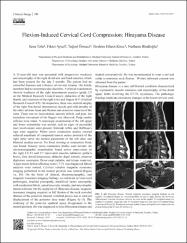Flexion-induced cervical cord compression: Hirayama disease

Göster/
Erişim
info:eu-repo/semantics/openAccessAttribution-NonCommercial 4.0 Internationalhttps://creativecommons.org/licenses/by-nc/4.0/Tarih
2019Üst veri
Tüm öğe kaydını gösterKünye
Tolu, S., Aysal, F., Örmeci, T., Kirez, İ. E. ve Hindioğlu, N. (2019). Flexion-induced cervical cord compression: Hirayama disease. Balkan Medical Journal, 36(3), 190-191. https://dx.doi.org/10.4274/balkanmedj.galenos.2019.2019.1.16Özet
A 15-year-old man was presented with progressive weakness and amyotrophy of the right distal arm and hand muscles, which had been present for the last 3 months. The patient had no comorbid diseases and a history of cervical trauma. His family members had no neuromuscular disorders. A clinical examination showed weakness of the right interosseous muscles (grade 3/5 on the Medical Research Council scale), abduction of the right thumb, and extension of the right wrist and fingers II-V (Medical Research Council 4/5). On inspection, there was marked atrophy of the right first dorsal interosseous muscle and mild atrophy of the other intrinsic hand and flexion and extension muscles of the wrist. There was no fasciculation, sensory deficit, and pain, but tremulous movement of his fingers was observed.
WoS Q Kategorisi
Q3Scopus Q Kategorisi
Q3Kaynak
Balkan Medical JournalCilt
36Sayı
3Bağlantı
https://dx.doi.org/10.4274/balkanmedj.galenos.2019.2019.1.16https://hdl.handle.net/20.500.12511/1660


















